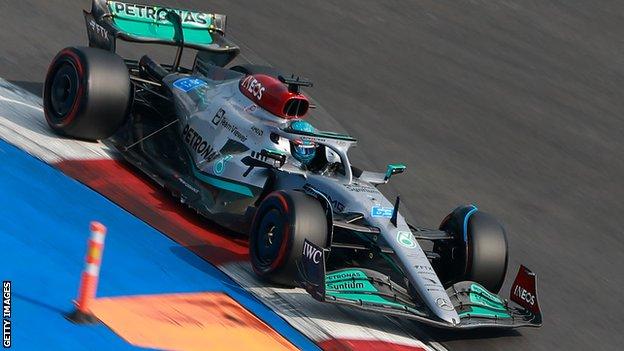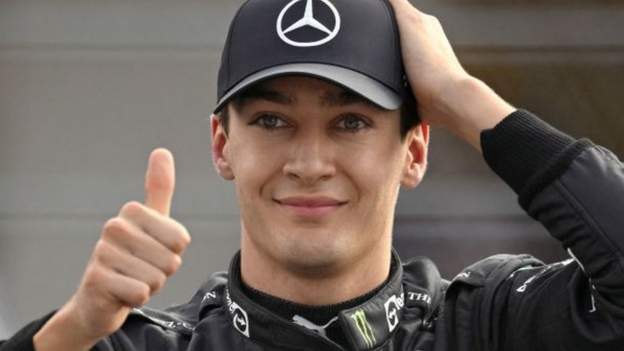
George Russell believes Mercedes have a “reasonable shot” of winning the Mexico City Grand Prix.
That might not sound like the most overwhelming level of confidence, but in the context of a season Max Verstappen and Red Bull have taken almost total control of, it is really saying something.
This has been a difficult year for Mercedes, and with just three races to go they are still to win a race. This looks like it could be their best chance yet – just a week after Hamilton came as close as he had done yet in the US Grand Prix in Austin, Texas.
Russell and Lewis Hamilton start second and third, behind the world champion, for a race that has not been won from pole position since 2016, when Hamilton did it.
Verstappen will still be a formidable opponent, still start as favourite. If he wins on Sunday, it will be his 14th victory of the season – a new all-time record.
But Mercedes have looked competitive all weekend at the Autodromo Hermanos Rodriguez, and Russell felt the 0.304-second gap by which Verstappen beat him to pole – a lot on one of the shorter laps of the season – flattered the Red Bull.
“It was a very difficult session,” Russell said. “The car has been feeling very good all weekend, and then my first lap in Q1, it was just awful. I was driving terribly and I just had no rhythm whatsoever.”
By the start of the final session – Q3 – Russell seemed to have his rhythm back. He was 0.143secs off Verstappen on their opening laps and felt he could do substantially better.
“The lap in Q3 was not a banker, but a good lap, a clean lap and I knew there was a lot more to come,” Russell said. “And when I started pushing more, I got bitten by the car.”
This was the problem with the Mercedes car that Hamilton described in the interview he did with BBC Sport and three selected other outlets in Austin last weekend, and which was published on Thursday.
“Taking the car to the limit,” Hamilton said, “is like creeping up behind a horse – you’re trying to get as close as possible. What’s the breaking point before it kicks you in the face? And you know it’s going to hurt when it hits your face.”
Russell said after qualifying: “I am disappointed because I felt like the team deserved pole position, but ultimately the points are on Sunday and we will be going for the win.
“It’s a shame but we are starting P2, second best qually of the year, and there are a lot of positives to take away.
“We think we have a reasonable shot, and having Lewis at the front as well gives us the opportunity to do something different on the strategy.”
Hamilton, too, felt he was in with a shot of what would have been his first pole of the year.
Fastest in both first and second qualifying, Hamilton had good reason to be confident going into the final session.
But he was adjudged to have cut the third corner on his first lap, and his time was disallowed. That meant he had to be a little cautious on his final run, because messing that up would have meant starting 10th. On top of that, he was suffering engine problems that slowed him out of the corners.
“No real major issues,” Hamilton said. “Some engine issues; some performance left on the table with that, unfortunately.
“Losing the first lap made it a bit more difficult because I had to keep it clean, so not able to push as hard as I would have liked.
“(The engine problem) started to appear in Q2 and then it was every run in Q3.
“Basically I was dropping out of power on exits of corners, so I definitely think we were losing quite a bit of time. It felt like an ignition issue but I will find out from the team.”
Mercedes said the problem was oscillation in the driveline.
Overall, though, Hamilton was happy.
“Second and third is not a bad position to start,” he said.
Russell felt Mercedes’ competitiveness was a consequence of the altitude. Mexico City is more than 2,200m above sea level, so the air is thin, which has a significant effect on F1 cars.
Although the track has long straights, teams run their cars in the highest downforce configuration possible because the low air density reduces the effectiveness of their aerodynamics.
It also reduces drag – and this is the key for Mercedes, for whom one of the most significant problems this year has been the draggy nature of their car.
Russell said: “Red Bull have a very efficient car and have been taking a huge amount of time out of us on straights. This weekend that has been less and it’s probably why we have had the fastest car this weekend.”
This race was won from third on the grid last year, from fourth in 2019, and second in 2018 and 2017.
Why is it so difficult to win from pole in Mexico, and why is qualifying second and third almost considered an advantage?
Part of the explanation is that the run to the first corner from the grid is more than 800m, one of the longest of the year, which gives the drivers behind a good opportunity to gain ground using the tow.
This is how Verstappen managed to grab the lead at the start last year, despite Mercedes having a front-row lock-out – although some of that was Valtteri Bottas, Russell’s predecessor in the team, not doing his job properly and failing to block the Red Bull.
The problem for Russell and Hamilton, though, is that the Red Bull remains a quicker car, and it is still prodigiously fast on the straights. Mercedes might have less of a drag disadvantage than usual, but overtaking the Red Bull will remain a problem.
Hamilton said: “It is always a tough race around here with track temperatures and tyres but these guys have been rapid all year and even when we are at our best, we are still losing out on straight-line speed.
“It will be difficult to get past them but we will give it our best shot and Turn One is an opportunity.”
Verstappen, who has won three of the last four races in Mexico, said: “I started everywhere except pole here and we won races so it is always important to have a good start.
“Our top speed is not too bad to defend when people are in the draft. We just need to focus. If we have good race pace it will be a good fight, anyway.”
